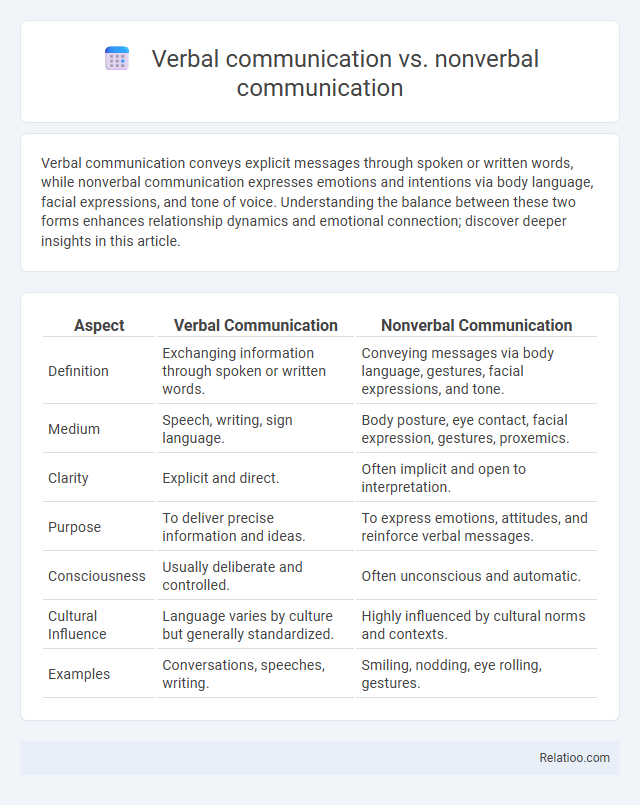Verbal communication conveys explicit messages through spoken or written words, while nonverbal communication expresses emotions and intentions via body language, facial expressions, and tone of voice. Understanding the balance between these two forms enhances relationship dynamics and emotional connection; discover deeper insights in this article.
Table of Comparison
| Aspect | Verbal Communication | Nonverbal Communication |
|---|---|---|
| Definition | Exchanging information through spoken or written words. | Conveying messages via body language, gestures, facial expressions, and tone. |
| Medium | Speech, writing, sign language. | Body posture, eye contact, facial expression, gestures, proxemics. |
| Clarity | Explicit and direct. | Often implicit and open to interpretation. |
| Purpose | To deliver precise information and ideas. | To express emotions, attitudes, and reinforce verbal messages. |
| Consciousness | Usually deliberate and controlled. | Often unconscious and automatic. |
| Cultural Influence | Language varies by culture but generally standardized. | Highly influenced by cultural norms and contexts. |
| Examples | Conversations, speeches, writing. | Smiling, nodding, eye rolling, gestures. |
Introduction to Verbal and Nonverbal Communication
Verbal communication involves the use of spoken or written language to convey messages, relying on words and syntax to express ideas clearly. Nonverbal communication encompasses facial expressions, body language, gestures, posture, eye contact, and tone of voice to transmit emotions and intentions without words. Nonverbal cues serve as subtle signals that enhance or contradict verbal messages, playing a critical role in the overall effectiveness of interpersonal communication.
Defining Verbal Communication
Verbal communication refers to the use of words and language to convey messages through speaking or writing, enabling clear and precise exchange of information. Nonverbal communication encompasses gestures, facial expressions, body language, and tone of voice, which complement or enhance verbal messages. Nonverbal cues are individual signals within nonverbal communication that provide context or emotional depth, such as eye contact or posture.
Defining Nonverbal Communication
Nonverbal communication encompasses all forms of conveying messages without spoken words, including gestures, facial expressions, posture, and eye contact. Unlike verbal communication, which relies on language and spoken dialogue, nonverbal communication transmits emotions and intentions often more powerfully through subtle actions known as nonverbal cues. These cues serve as critical components for interpreting meaning beyond verbal content, influencing perception in personal and professional interactions.
Key Differences Between Verbal and Nonverbal Communication
Verbal communication involves the use of words, either spoken or written, to convey messages directly, while nonverbal communication relies on body language, gestures, facial expressions, and tone of voice to express meaning without words. Nonverbal cues are specific signals within nonverbal communication that provide context or emotional subtext, such as eye contact or posture. Understanding these key differences helps you interpret messages more accurately and respond appropriately in various interactions.
The Importance of Verbal Communication in Everyday Life
Verbal communication allows you to express complex ideas clearly and effectively, making it essential for successful interpersonal relationships and professional interactions. Nonverbal communication, including gestures, facial expressions, and tone, complements spoken words by providing context and emotional nuance. Understanding nonverbal cues enhances your ability to interpret messages accurately, but verbal communication remains the primary tool for conveying explicit information in everyday life.
The Power of Nonverbal Cues and Signals
Nonverbal cues, such as facial expressions, gestures, and body language, convey emotions and intentions more powerfully than verbal communication alone, often shaping interpersonal interactions and perceptions subconsciously. Unlike spoken words, nonverbal communication includes tone of voice, posture, eye contact, and proxemics, which together provide context and amplify the meaning behind messages. Recognizing and interpreting these nonverbal signals enhances effective communication, builds trust, and prevents misunderstandings across diverse social and professional settings.
Advantages of Verbal Communication
Verbal communication offers clear advantages in ensuring precise and direct exchange of information, allowing you to articulate complex ideas and emotions explicitly. Unlike nonverbal communication and nonverbal cues, verbal communication reduces misunderstandings by using structured language and tone to convey intent. This clarity enhances collaboration, decision-making, and relationship-building in personal and professional settings.
Advantages of Nonverbal Communication
Nonverbal communication, encompassing facial expressions, gestures, posture, and eye contact, offers advantages such as enhancing message clarity and conveying emotions more effectively than verbal communication alone. It provides immediate feedback and can bridge language barriers, making it essential in multicultural and multilingual interactions. Unlike verbal communication, nonverbal cues often reveal true feelings and attitudes, strengthening trust and empathy in interpersonal relationships.
Challenges in Interpreting Verbal vs Nonverbal Messages
Interpreting verbal communication can be difficult due to factors like language barriers, tone ambiguity, and context dependence, which can lead to misunderstandings. Nonverbal communication, including body language and facial expressions, presents challenges because cues can be subtle, culturally specific, or contradictory to spoken words, making accurate interpretation complex. Your ability to effectively decode these verbal and nonverbal signals is crucial for successful communication and avoiding misinterpretations.
Integrating Verbal and Nonverbal Communication for Effective Interaction
Integrating verbal and nonverbal communication enhances your ability to convey messages clearly, as verbal communication involves spoken or written words while nonverbal communication includes body language, facial expressions, and gestures. Nonverbal cues, such as eye contact, posture, and tone of voice, reinforce or contradict verbal messages, making alignment between both essential for effective interaction. Mastering this integration improves understanding, builds trust, and reduces miscommunication in personal and professional settings.

Infographic: Verbal communication vs Nonverbal communication
 relatioo.com
relatioo.com